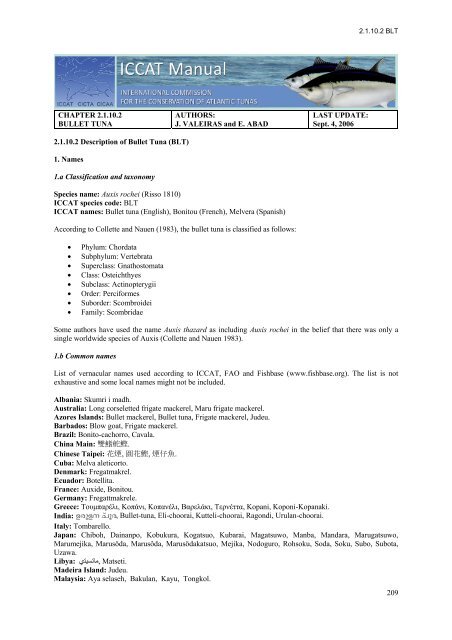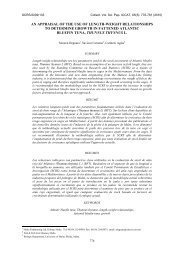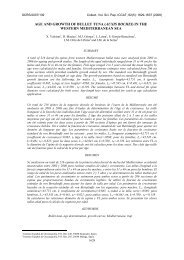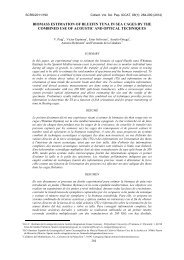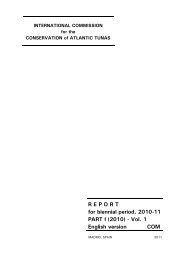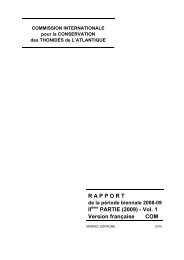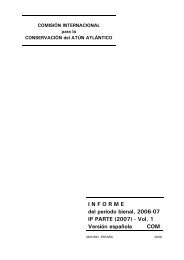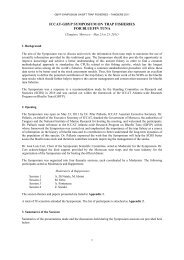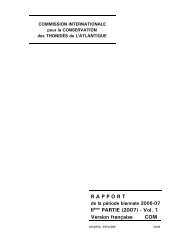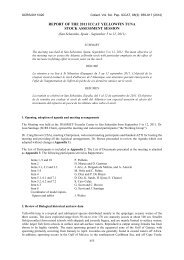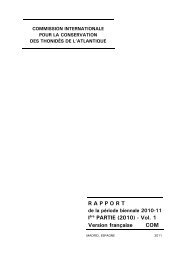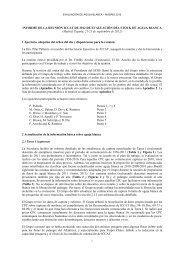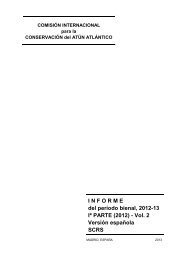You also want an ePaper? Increase the reach of your titles
YUMPU automatically turns print PDFs into web optimized ePapers that Google loves.
CHAPTER 2.1.10.2<br />
BULLET TUNA<br />
2.1.10.2 Description of <strong>Bullet</strong> Tuna (BLT)<br />
1. Names<br />
1.a Classification and taxonomy<br />
AUTHORS:<br />
J. VALEIRAS and E. ABAD<br />
Species name: Auxis rochei (Risso 1810)<br />
ICCAT species code: BLT<br />
ICCAT names: <strong>Bullet</strong> <strong>tuna</strong> (English), Bonitou (French), Melvera (Spanish)<br />
According to Collette and Nauen (1983), the bullet <strong>tuna</strong> is classified as follows:<br />
• Phylum: Chordata<br />
• Subphylum: Vertebrata<br />
• Superclass: Gnathostomata<br />
• Class: Osteichthyes<br />
• Subclass: Actinopterygii<br />
• Order: Perciformes<br />
• Suborder: Scombroidei<br />
• Family: Scombridae<br />
LAST UPDATE:<br />
Sept. 4, 2006<br />
2.1.10.2 BLT<br />
Some authors have used the name Auxis thazard as including Auxis rochei in the belief that there was only a<br />
single worldwide species of Auxis (Collette and Nauen 1983).<br />
1.b Common names<br />
List of vernacular names used according to ICCAT, FAO and Fishbase (www.fishbase.org). The list is not<br />
exhaustive and some local names might not be included.<br />
Albania: Skumri i madh.<br />
Australia: Long corseletted frigate mackerel, Maru frigate mackerel.<br />
Azores Islands: <strong>Bullet</strong> mackerel, <strong>Bullet</strong> <strong>tuna</strong>, Frigate mackerel, Judeu.<br />
Barbados: Blow goat, Frigate mackerel.<br />
Brazil: Bonito-cachorro, Cavala.<br />
China Main: .<br />
Chinese Taipei: , , .<br />
Cuba: Melva aleticorto.<br />
Denmark: Fregatmakrel.<br />
Ecuador: Botellita.<br />
France: Auxide, Bonitou.<br />
Germany: Fregattmakrele.<br />
Greece: , , , , , Kopani, Koponi-Kopanaki.<br />
India: , <strong>Bullet</strong>-<strong>tuna</strong>, Eli-choorai, Kutteli-choorai, Ragondi, Urulan-choorai.<br />
Italy: Tombarello.<br />
Japan: Chiboh, Dainanpo, Kobukura, Kogatsuo, Kubarai, Magatsuwo, Manba, Mandara, Marugatsuwo,<br />
Marumejika, Marusöda, Marusôda, Marusödakatsuo, Mejika, Nodoguro, Rohsoku, Soda, Soku, Subo, Subota,<br />
Uzawa.<br />
Libya: , Matseti.<br />
Madeira Island: Judeu.<br />
Malaysia: Aya selaseh, Bakulan, Kayu, Tongkol.<br />
209
ICCAT MANUAL, 1 s t Edition (January 2010)<br />
Malta: Bizu, Mazzita, Pizzintun, Sgamirru, Tombitombi, Tumbreall, Tumbrell, Zgamirru.<br />
Mexico: Bonito, Melva, Melvera.<br />
Micronesia: Mackerel <strong>tuna</strong>, Yasiuneiu-yauma.<br />
Mozambique: Judeu melveira.<br />
Nicaragua: Melvera.<br />
Norway: Auxid.<br />
Papua New Guinea: <strong>Bullet</strong> <strong>tuna</strong>.<br />
Peru: Barrilete negro.<br />
Philippines: Aloy, Bodboran, Bodboron, Bonito, Buboron, Budburon, <strong>Bullet</strong> <strong>tuna</strong>, Buroboto bilog, Burot,<br />
Frigate <strong>tuna</strong>, Kuringding, Lubak-lubak, Mangko, Manko, Perit, Pidlayan, Pirit, Tangi, Tulingan, Turingan,<br />
Vahuyo.<br />
Poland: Tazar marun.<br />
Portugal: Judeu.<br />
Slovenia: Trupec.<br />
South Africa: <strong>Bullet</strong> <strong>tuna</strong>, Koeël-<strong>tuna</strong>.<br />
Spain: Melva, Melvera.<br />
Sri Lanka: Eli-choorai, Kutteli-choorai.<br />
St Helena: Mackerel <strong>tuna</strong>.<br />
Sweden: Auxid.<br />
Turkey: Gobene baligi, Tombik baligi.<br />
United Kingdom: <strong>Bullet</strong> <strong>tuna</strong>, Frigate mackerel, Frigate <strong>tuna</strong>.<br />
Uruguay: <strong>Bullet</strong> <strong>tuna</strong>, Sanguzo.<br />
United States of America: <strong>Bullet</strong> mackerel, <strong>Bullet</strong> <strong>tuna</strong>.<br />
Vietnam: <strong>Bullet</strong> <strong>tuna</strong>, Cá Ng o.<br />
2. Identification<br />
Figure 1. Drawing of an adult Auxis rochei (by A. López ‘Tokio’).<br />
Characteristics of Auxis rochei (see Figure 1 and Figure 2)<br />
<strong>Bullet</strong> <strong>tuna</strong> is a small <strong>tuna</strong> species. Maximum size in east Atlantic is 51 cm fork length (Neves dos Santos and<br />
García 2006). In the Gibraltar Strait is 47 cm fork length and about 1.9 kg weight (Rodríguez-Roda 1966).<br />
Common size is 35 cm (Collete and Nauen 1983; Collete 1986).<br />
Colour:<br />
210<br />
• Colour bluish iridescence on dorsal parts turning to deep purple or almost black on the head.
2.1.10.2 BLT<br />
Pattern of 15 or more dark bars or wavy lines, oblique to nearly vertical, in the scaleless area above<br />
lateral line.<br />
White belly without stripes or spots.<br />
Pectoral and pelvic fins are purple, with black inner sides.<br />
Black patch at postero-ventral border of eye.<br />
External:<br />
Body robust elongate and rounded.<br />
Body naked, except for the corselet which is well developed. Corselet wide in its posterior part (more<br />
than 6 scales wide under second dorsal fin origin, usually 10 to 15).<br />
Strong median keel on each side of caudal peduncler, between two smaller keels.<br />
Two dorsal fins separated by a large interspace (at least equal to length of first dorsal fin base). Second<br />
dorsal lower than first, followed by 8 finlets.<br />
Anal fin followed by 7 finlets.<br />
Short pectoral fin which does not reach the beginning of scaleless area above corselet. Pectoral rays: 22-<br />
25.<br />
Dorsal spines: 10-12.<br />
Gillrakers on first arch: 38-47.<br />
Inter-pelvic process single and very large, equal to length of pelvic fins.<br />
Internal:<br />
Swimbladder absent.<br />
Right lobe of liver very long, extending the length of the body cavity and left lobe greatly reduced.<br />
Vertebrae: 39.<br />
Cutaneus artery present but divided into separate dorsal and ventral branches. The ventral branch is<br />
very poorly developed.<br />
Figure 2. Synthesis of the most outstanding characteristics of Auxis rochei (by A. López ‘Tokio’).<br />
3. Distribution and population ecology<br />
3.a Geographical distribution<br />
Short pectoral fin which does not<br />
reach the beginning of scaleless<br />
area above corselet<br />
Pattern of 15 or more dark bars or<br />
wavy lines, oblique to nearly vertical,<br />
in the scaleless area above lateral line<br />
Strong median keel on each side<br />
of caudal peduncler, between two<br />
smaller keels<br />
The genus Auxis is distributed worldwide in tropical and subtropical waters. The confusion surrounding the<br />
identification of the species of Auxis is reflected in their reported distribution in the world’s oceans. Auxis is<br />
distributed in both sides of the tropical and subtropical Atlantic Ocean, including the Mediterranean, Caribbean<br />
Sea and Gulf of Mexico (Figure 3). Latitudinal range reported for genus in Atlantic is from 45ºN to 35ºS.<br />
211
ICCAT MANUAL, 1 s t Edition (January 2010)<br />
In the eastern Atlantic is reported as far north as Norway and as far south as South Africa waters. In the western<br />
Atlantic off the east coast of North America has been recorded from Gulf of Maine, (Cape Cod). Off the Atlantic<br />
coast of South America the species is recorded to Mar del Plata (Argentina).<br />
Figure 3. Geographical distribution of Auxis sp. (FAO. c2001-2009. Compilation of aquatic species distribution<br />
maps of interest to fisheries. In FAO Fisheries Department [online]. Rome. [15 sept. 2009].<br />
http://www.fao.org/fishery/collection/fish_dist_map).<br />
3.b Habitat preferences<br />
<strong>Bullet</strong> <strong>tuna</strong> is an epipelagic and neritic fish as well as oceanic occurring in warm waters. Larvae have a high<br />
temperature tolerance of at least 21.6 to 30.5ºC, (the widest among <strong>tuna</strong> species studied), their optimum is 27-<br />
27.9ºC.<br />
The species has a strong schooling behaviour.<br />
3.c Migrations<br />
Information concerning to migration patterns is scarce and fragmented (Rey and Cort 1981). Several authors<br />
have suggested a genetic migration from the Atlantic Ocean to the spawning areas in the Mediterranean trough<br />
the Gibraltar Strait (Sabatés and Recasens 2001).<br />
3.d Recruitment<br />
Knowledge of the early life stages in <strong>tuna</strong>s is very scarce. It is assumed that larval period is short. During the<br />
first life stages bullet <strong>tuna</strong> are not caught and juvenile life history is unknown. Immature fish first appear in<br />
fishery from around 25 cm of fork length.<br />
4. Biology<br />
4.a Growth<br />
Bök and Oray (2001) studied age and growth by otoliths and dorsal spines analysis and found five age groups (0-<br />
4) for the Aegean Sea and the eastern Mediterranean. Von Bertalanffy growth parameters are showed in Table 1.<br />
Rodriguez-Roda (1983) studied vertebrae of 27 bullet <strong>tuna</strong> from Atlantic area near Gibraltar strait and found four<br />
age groups (1-4).<br />
212
Table 1. Growth parameters for bullet <strong>tuna</strong> (L-1, t0 in y).<br />
4.b Length-Weight relationship<br />
Published length-weight relationships for several geographical areas in Atlantic are showed in Table 2.<br />
Table 2. Published bullet <strong>tuna</strong> length-weight relationships.<br />
4.c Reproduction<br />
Spawning<br />
2.1.10.2 BLT<br />
Growth Parameter Area Country Reference<br />
N FL range Method<br />
L k t0 (cm)<br />
45.26292 0.39722 -1.6044 Aegean Sea and Eastern Turkey Bök and Oray, 2001 630 28.5-44.5 Dorsal spine,<br />
Mediterranean<br />
otoliths<br />
45.08422 0.33988 -1.5984 Aegean Sea and Eastern Turkey Bök and Oray, 2001 311 males 30-44.5 Dorsal spine,<br />
Mediterranean<br />
otoliths<br />
47.76151 0.29235 -2.3649 Aegean Sea and Eastern Turkey Bök and Oray, 2001 309 females 32.6-44.5 Dorsal spine,<br />
Mediterranean<br />
otoliths<br />
Equation N FL range (cm) Sex Area Country Reference<br />
W= 0.0076 x FL 3.24 936 28.5-44.5 All Aegean Sea and Eastern<br />
Mediterranean<br />
Turkey Bök and Oray, 2001<br />
W= 0.000156 x FL 4.29 311 30-44.5 Male Aegean Sea and Eastern<br />
Mediterranean<br />
Turkey Bök and Oray, 2001<br />
W= 0.000719 x FL 3.89 309 32.6-44.5 Female Aegean Sea and Eastern<br />
Mediterranean<br />
Turkey Bök and Oray, 2001<br />
W= 0.00001005 x FL 3.12987 744 34-45 All Gibraltar Strait Spain Rodríguez-Roda, 1966<br />
W= 0.00559 x FL 3.29 458 25.9-47 All Western Mediterranean Spain Macías et al., 2006<br />
This species is a multiple spawner with asynchronous oocyte development that carried out several spawning step<br />
by reproductive season (Niiya, Y, 2001; Macías et al. 2005).<br />
The spawning season may vary from region to region depending on the hydrographical regime: in many parts of<br />
the Mediterranean and in the Straits of Gibraltar, maturing fish are common from May onwards, and more than<br />
30% are spent by September. The spawning period in the Mediterranean has been reported to occur from June to<br />
September (Ehrenbaum 1924; Piccinetti et al. 1996; Alemany 1997; Macías et al. 2005).The spawning period of<br />
this species in the Aegean Sea and in the Mediterranean Sea was determined to be from March to September<br />
(Bök and Oray 2001). In western African coasts the spawning occurs from April to June in the gulf of Guinea<br />
and September-October to March off Congo and Angola (Rudomiotkina 1984).<br />
In large areas of the Gulf of Mexico, peaks of batch spawning are reported from March to April and from June to<br />
August, while in the coastal waters from Cape Hatteras to Cuba and in the Straits of Florida, the spawning<br />
season begins in February.<br />
Maturity<br />
Fork length at first maturity off Gibraltar is 35 cm in females and 36.5 cm in males (Rodriguez-Roda 1966). In<br />
the Aegean and in the Mediterranean Seas, Auxis rochei reached the sexual maturity at 34.4 cm length and the<br />
development of the gonads is almost the same for both genders. The gonads are mature after the month of March<br />
for most of the male or female individuals (Bök and Oray 2001).<br />
Sex ratio<br />
The sex ratio in Aegean Sea is approximately 1:1 (Bök and Oray 2001). Macías et al. (2005) found a sex ratio of<br />
1:1.7 at western Mediterranean catches.<br />
213
ICCAT MANUAL, 1 s t Edition (January 2010)<br />
Fecundity<br />
This species is a fish with indeterminate fecundity (Macías et al. 2005). In the Mediterranean the average<br />
fecundity. The average fecundity is 233941 oocytes by spawning batch (Macías et al. 2006).<br />
4.d First life stages<br />
Eggs and Larvae<br />
Eggs are pelagic, 0.82-0.88 mm of diameter and with one oil globule (0.24-0.25 mm of diameter). The yolk is<br />
homogeneus. The hatch size is 2.14 mm. The embryo presents melanophores, green chromatophores and 6-14<br />
stellate chromatophores on oil globule. Larvae present pigmentation on midbrain, hindbrain, gut, cleithral<br />
symphysis dorsal and ventral margins of tail (Richards 2005).<br />
4.e Diet<br />
Food is primarily selected by the size of gillrakers. The species feeds on fish, crustaceans, cephalopods and<br />
others. Fish prey largely of small pelagic fishes, particularly anchovies and other clupeoids (Etchevers 1957).<br />
Crustaceans are especially planktonic crustaceans as megalops and stomatopods larvae.<br />
Predators: several <strong>tuna</strong> species, pelagic sharks, billfishes and big pelagic fish (Coryphaena hippurus, Alepisaurus<br />
sp, Sphyraena sp.). Because of its abundance, they are considered an important element of the food chain, being<br />
a forage prey for other commercial species (Olson 1982).<br />
4.f Physiology<br />
There is a lack on information on this topic.<br />
4.g Behaviour<br />
This species makes large schools of similar sized individuals. Often mixes with Auxis thazard in same school.<br />
4.h Natural mortality<br />
There is a lack on information available on this biological parameter.<br />
5. Fisheries biology<br />
5.a Populations/Stock structure<br />
There is little information available to determine the stock structure of bullet <strong>tuna</strong>. Current information does not<br />
allow for an evaluation of stock status.<br />
5.b Description of fisheries: catches and effort<br />
<strong>Bullet</strong> <strong>tuna</strong> is exploited mainly by surface gears and artisanal fisheries as trolling lines, handlines, small-scale<br />
longlines, and a wide variety of nets, especially traps, gill or drift nets, ring nets, beach seines, otter trawls, and<br />
purse seines. In some of these fisheries, Auxis species are taken incidentally as by-catch as in purseseine<br />
fisheries for yellowfin and skipjack <strong>tuna</strong>.<br />
In the Atlantic, catches of Auxis species are usually not identified to species. Thus in the total catch of frigate<br />
<strong>tuna</strong>, the proportion of each of the two species is not known. However, almost the entire Venezuela, Atlantic and<br />
Mediterranean catch is supposedly Auxis rochei (Collette and Nauen 1983).<br />
Annual catches reach 3,634 t in 1990 (Figure 4). Average estimated landings from 1980 to 2004 is 581 t.<br />
Unknown quantities of bullet <strong>tuna</strong> are landing and recorded as frigate <strong>tuna</strong> in the Atlantic (ICCAT 2006).<br />
214
4000<br />
3500<br />
3000<br />
2500<br />
2000<br />
1500<br />
1000<br />
500<br />
0<br />
1980<br />
1981<br />
Figure 4. Catch distribution of bullet <strong>tuna</strong> in the Atlantic Ocean for 1980-2004 (t).<br />
BLT<br />
1982<br />
1983<br />
1984<br />
1985<br />
1986<br />
1987<br />
1988<br />
1989<br />
1990<br />
1991<br />
1992<br />
2.1.10.2 BLT<br />
6. Bibliography<br />
ALEMANY, F. 1997. Ictioplancton del Mar Balear. Ph. D. thesis, Univ. Illes Balears.<br />
BÖK, T. and K. Oray, 2001. Age and growth of bullet <strong>tuna</strong> Auxis rochei (Risso 1810) in Turkish waters. Col.<br />
Vol. Sci. Pap. ICCAT, 52: 708-718.<br />
COLLETE, B. B. 1986. Scombridae. In: P.J.P. Whitehead, M.-L. Bauchot, J.-C. Hureau, J. Nielsen, and E.<br />
Tortonese (eds.), Fishes of the North-eastern Atlantic and the Mediterranea. Vol II. pp. 981-997. Unesco,<br />
Paris.<br />
COLLETTE, B. B. and C. E. Nauen., 1983 FAO species catalogue. Vol. 2. Scombrids of the world. An<br />
annotated and illustrated catalogue of <strong>tuna</strong>s, mackerels, bonitos and related species known to date. FAO<br />
Fish. Synop. 125(2). 137 pp.<br />
EHRENBAUM, E. 1924. Scombriformes. Report on the Danish Oceanografical Expeditions 1908-1910.<br />
Mediterranean and Adjacent Seas, 2 (A, 11).<br />
ETCHEVERS, S. L., 1976. Incidencia de clupeoideos en la alimentacion de las caballas: Euthynnus alletteratus<br />
(Rafinesque 1976) y Auxis thazard (Lacepède) en la costa noreste de Margarita. Lagena (37-38):9-11.<br />
ICCAT, 2006. Report for biennial period, 2004-05 Part II (2005), Vol. 2, Executive Summaries on species:<br />
Small Tunas: 128-135.<br />
MACÍAS, D., Gómez-Vives, M. J,. de la Serna, J. M., 2005. Some reproductive aspects of bullet <strong>tuna</strong> (Auxis<br />
rochei) from the south western Spanish Mediterranean. Collect. Doc. Cient. Vol. ICCAT, 58(2): 484-495.<br />
MACÍAS, D., Lema, L., Gómez-Vives M. J., and J. M. de la Serna, 2006. A preliminary approach to the bullet<br />
<strong>tuna</strong> (Auxis rochei) fecundity in the Spanish Mediterranean. Collect. Vol. Sci. Pap. ICCAT, 59(2): 571-578.<br />
MACÍAS, D., Lema, L., Gómez-Vives, M. J., Ortiz de Urbina, J. M. and de la Serna, J. M., 2006. Some<br />
biological aspects of small <strong>tuna</strong>s (Euthynnus alletteratus, Sarda sarda & Auxis rochei) from the south<br />
western Spanish Mediterranean traps. Collect. Vol. Sci. Pap. ICCAT, 59(2): 579-589.<br />
NEVES DOS SANTOS, M. and A. García, 2006. Observations on the catches of small <strong>tuna</strong>s from a trap off the<br />
Algarve (southern Portugal). Collect. Vol. Sci. Pap. ICCAT, 58: in press.<br />
NIIYA, Y. 2001. Maturation cycle and batch fecundity of the bullet <strong>tuna</strong>, Auxis rochei, off Cape Ashizuri,<br />
southwestern Japan. Nippon Suisan Gakkaishi, 67 (1): 10-16. Jan 2001.<br />
OLSON, R. J., 1982. Feeding and energetics studies of yellowfin <strong>tuna</strong>; food for ecological thought. Col. Vol.<br />
Sci. Pap. ICCAT, 17:444-57.<br />
PICCINETTI, C., Piccinetti-Manfrin, G. and Soro, S. 1996. Larve di Tunnidi in the Mediterranean. Biol. Mar.<br />
Medit., 3: 303-309.<br />
REY, J. C. and Cort, J. L., 1981. Contribution à la conaissance de la migration des Escombridae en Mediterranée<br />
Occidentale. Rapp. P-V, Commn. Int. Explor. Scient. Mer Méditerr., 27: 97-98.<br />
Year<br />
1993<br />
1994<br />
1995<br />
1996<br />
1997<br />
1998<br />
1999<br />
2000<br />
2001<br />
2002<br />
2003<br />
2004<br />
215
ICCAT MANUAL, 1 s t Edition (January 2010)<br />
RICHARDS, W. J., (ed.), 2005. Early Stages of Atlantic Fishes: An identification guide for the western central<br />
North Atlantic. CRC Press, Taylor and Francis Group, Boca Raton, FL, 2640 pp.<br />
RODRÍGUEZ-RODA, J. 1966. Estudio de la bacoreta, Euthynnus alletteratus (Raf.), bonito, Sarda sarda<br />
(Bloch) y melva Auxis thazard (Lac.), capturados por las almadrabas españolas. Invest. Pesq. 30: 247-92.<br />
RODRÍGUEZ-RODA, J., 1983. Edad y crecimiento de la melva, Auxis rochei (Risso), del Sur de España. Invest.<br />
Pesq. (Barc.), 47(3): 397-402.<br />
RUDOMIOTKINA, G. P., 1984. New data on reproduction of Auxis spp. In the Gulf of Guinea. Collect. Vol.<br />
Sci. Pap. ICCAT, 20(2): 465-468.<br />
SABATÉS, A. and Recasens, L. 2001. Seasonal distribution and spawning of small <strong>tuna</strong>s, Auxis rochei (Risso)<br />
and Sarda sarda (Bloch) in the northwestern Mediterranean. SCI. Mar., 65 (2): 95-100.<br />
UCHIDA, R. N., 1981. Synopsis of biological data on frigate <strong>tuna</strong>, Auxis thazard, and bullet <strong>tuna</strong>, A. rochei.<br />
NOAA Tech. Rep. NMFS Circ., (436):63 p. Issued also as FAO Fish. Synop., (124): 63 p.<br />
216


